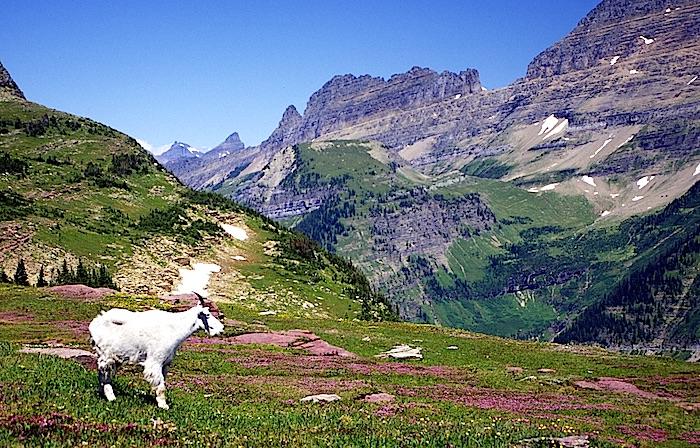
Mountain goat studies are continuing at Glacier National Park/Kurt Repanshek
If you've been to Glacier National Park, and spent time in the Logan Pass area, you just might have had an impact on the mountain goats that hang out there, and not necessarily a good one.
You see, most of the park's goats that aren't used to humans stick to cliffs and ledges, and only occasionally trot off to meadows to browse the vegetation. Those goats that are used to our presence spend more time in meadows and along park roads.
Those are some of the initial findings coming from a multi-year study of mountain goats in Glacier by park staff in partnership with the University of Montana, and Montana Fish, Wildlife and Parks. The three-year study began in late summer 2013 and is designed to provide information on how mountain goats are affected by roads, people, and trails near Logan Pass. The study is a critical component of the current Going-to-the-Sun Road Corridor Management planning effort, which identified human-wildlife interactions within the corridor as an issue of concern, park officails said.
Six mountain goats received radio collars in 2013 and an additional 18 animals received radio collars in summer 2014. A total of 24 mountain goats, consisting of seven males and 17 females, received collars and successfully overwintered in the Mount Cannon and Hidden Creek drainage. VHF and GPS radio collars are utilized to collect location data. VHF collars only collect a data point when they are located by an observer on the ground or in an aircraft, whereas GPS collars collect a data point every few hours and then transmit that information via satellite to a researcher’s computer.
As the study goes on and more data are collected, the initial findings of how mountain goats behave around humans could change.
In addition to tracking radio-collared animals, researchers will continue observational data collection. Mountain goats may be temporarily marked with paint in specific situations. A University of Montana graduate student will lead most of the observational research study activities, with oversight by park managers. No mountain goat captures will occur this summer.
The key objectives of the project are to determine:
* Whether the same or different goats use Logan Pass and the Highline Trail area yearly;
* Timing of goat movements into and beyond the Logan Pass/Highline Trail area;
* Relationships between goats and humans, particularly patterns of habituation and goat-directed aggression, if at all, to humans.
Additional components of the study will assess the extent to which goat reliance on humans results in ‘unnatural’ behavior including: association with human activities, facilities and infrastructure; use of roads, popular adjacent trails, and people as safe havens from predators; and effectiveness of possible deterrents to habituated goats.
To date, 22 goats are still radio-collared. Two mountain goat collars are no longer transmitting. One collar apparently suffered a malfunction of the early release mechanism and fell off a male goat around July 1. Evidence indicates that the goat was not a victim of predation or a fall and is assumed to still be alive.
The other mountain goat, an approximately seven-year-old female, was discovered near the base of a cliff on July 6, the apparent victim of a substantial fall. Samples were collected from this animal for laboratory analysis to determine her state of health.
Data on mountain goat mortality will assist park managers and researchers in documenting causes and timing of deaths of mountain goats to gain a clear idea on what factors are influencing the mountain goat population within the park.
Visitors are reminded to keep a safe distance from wildlife. Park regulations require visitors to stay at least 100 yards away from bears and wolves, and at least 25 yards from any other animals.



Add comment